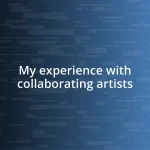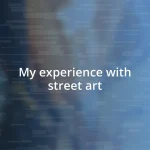Key takeaways:
- Art history research reveals personal narratives behind artworks, deepening appreciation for the emotional and societal influences on artists.
- Understanding art historical context enhances interpretation by connecting artworks to the socio-political and cultural conditions of their time.
- Utilizing various research methodologies and tools, including digital resources and physical experiences, enriches insights and promotes ongoing dialogue about art.

Understanding Art History Research
Understanding art history research is like peeling an onion—layer by layer, I uncover stories that reflect societies and cultures. Often, I find myself lost in the details of a particular artwork, asking, “What was the artist experiencing at that moment?” This curiosity drives me to explore archives, old letters, and even contemporary critiques, often leading to surprising connections I hadn’t anticipated.
At one point, while digging into the works of an obscure 19th-century painter, I stumbled across an old diary that revealed the struggles the artist faced. This personal glimpse reshaped my perspective on their work, highlighting how deeply intertwined art is with personal experiences. I can’t help but wonder, for every artwork we admire, what untold stories lie hidden behind the brushstrokes?
Moreover, researching art history gives me a deeper appreciation for how it mirrors the ebb and flow of human emotions and societal changes. Every era has its unique voice, and through my studies, I feel a responsibility to convey those narratives. Isn’t it fascinating how a single painting can spark countless discussions and reflections across generations? This interconnectedness is what keeps my passion for art history alive and thriving.

Importance of Art Historical Context
Understanding the historical context of art is vital. It allows me to see the artwork within the broader tapestry of its time. Once, while researching a Renaissance piece, I discovered the political unrest of that era, which deeply influenced the artist’s use of color and symbolism. Recognizing this connection transformed my comprehension of the piece.
When I reflect on specific artworks, I realize that they often serve as windows into the emotions and thoughts of a society. A specific encounter that stood out for me was when I viewed a modern piece at a gallery; the artist had drawn inspiration from a recent event that had impacted our community. This experience redefined my understanding of contemporary art and its power to comment on current issues.
Moreover, I feel that understanding art historical context enriches not only my perspective but also the viewer’s experience. By sharing these insights, I can guide others to appreciate deeper meanings behind the strokes and colors. Each artwork invites a conversation about its time, making history not just something we learn, but something we feel and engage with on a personal level.
| Aspect | Importance |
|---|---|
| Historical Background | Provides insight into societal influences that shaped the art. |
| Artist’s Intent | Reveals what the artist aimed to express within their context. |
| Cultural Significance | Helps understand shared values and beliefs during the artwork’s creation. |

Methodologies in Art Historical Research
Art historical research employs various methodologies, each offering a unique lens through which to analyze and interpret works. I’ve often relied on visual analysis, where the composition, color palette, and materials of a piece speak volumes about its context. For instance, during a study of Baroque art, I found that the dramatic use of light not only enhanced the emotional intensity but also reflected the religious fervor of the time. It’s a reminder that sometimes the artwork itself holds the keys to its own story.
Here are some methodologies that I’ve found particularly effective in my research:
- Formal Analysis: Examining the visual elements like line, form, color, and texture to grasp the artwork’s aesthetic and emotional impact.
- Iconographic Analysis: Interpreting symbols and motifs within the artwork to uncover deeper meanings or allegorical themes.
- Contextual Analysis: Considering the socio-political, historical, and cultural backdrop that influenced the creation of the artwork.
- Comparative Study: Analyzing similarities and differences between artworks or artists to draw broader conclusions about movements or periods.
- Interdisciplinary Approaches: Integrating perspectives from related fields, such as literature or anthropology, to enrich understanding and context.
Each of these methods has its own charm and challenges. I remember working with interdisciplinary approaches, feeling a sense of wonder when art echoed themes I had seen in literature. It was as if the artwork was inviting me into a rich dialogue between the two mediums, allowing for a harmonious blend of insights. This interplay often ignites my passion further, making the research process not just informative, but exhilarating.

Analyzing Artworks and Artists
Analyzing artworks and their creators goes beyond mere observation; it requires an immersion into the artist’s world. I once spent hours examining a piece by Frida Kahlo, drawn into her vivid imagery and raw emotional expression. I couldn’t help but wonder—what was she feeling in those moments of creation? This reflection revealed not just her struggle with identity and pain, but also my own connection to the universal themes of resilience that her art embodies.
The artists’ intentions often mirror the complexities of their time, and I’ve found digging into their biographies can illuminate this. Take Vincent van Gogh, for instance; knowing about his tumultuous life, I could see the anguish in his brushstrokes during my visit to a local exhibit. It struck me how personal turmoil often translates into profound art. This realization prompts me to question—how many artists channel their pain into creation, and how can we honor that emotional journey?
As I analyze art, I feel a sense of responsibility to communicate the nuanced layers behind each piece. Some artworks seem to invite dialogue, almost as if they’re whispering secrets about their creators. I remember discussing a contemporary installation with a friend, where we both felt a distinct shift in our perspectives as we peeled back the layers of meaning. It was exhilarating to share in that moment of discovery together—art can spark that kind of reflection, turning individual interpretations into shared understanding.

Challenges in Art Research Practices
Art research practices come with their own unique set of challenges that can sometimes feel daunting. I remember when I was sifting through archival materials for a project on Renaissance painters. The disorganization of some collections was overwhelming. You might find yourself asking, how do you piece together a narrative when the primary sources are scant or muddled? It takes patience and creativity to fill in those gaps.
Another challenge I’ve faced involves the accessibility of artworks. During a trip to a museum, I found it frustrating when certain pieces were not displayed, limiting my ability to understand the context of the artist’s oeuvre. It raises an important question: how much does physical access influence our comprehension of art? The ability to see, touch, and experience artworks firsthand adds layers of meaning that can’t always be captured in literature or digital forms.
Navigating the biases within art history is also a significant hurdle. I recall an enlightening discussion with a colleague regarding how often we overlook marginalized voices in the field. It made me reflect—how can we enrich our understanding of art history by incorporating diverse narratives? The journey to create a more inclusive perspective is ongoing and crucial, yet it demands that we actively question the very canon we’ve often accepted as definitive.

Tools for Effective Art Research
While researching art, I find that using a variety of tools can dramatically enhance my understanding. Digital databases like JSTOR and Google Arts & Culture have been invaluable in providing me access to scholarly articles and extensive collections. I remember stumbling across an obscure article on surrealism that opened my eyes to the psychological underpinnings of artists like Salvador Dalí—who knew research could be so exhilarating?
Another essential tool in my arsenal is social media. I often browse platforms like Instagram and Twitter to follow contemporary artists and art historians. This not only keeps me updated on new trends but also offers a peek behind the scenes. It’s fascinating to hear firsthand how artists discuss their work and inspirations—have you ever read an artist’s post and felt an instant emotional connection with their creative process?
Lastly, I can’t stress enough the importance of physical visits. Standing before a genuine artwork is an entirely different experience than viewing it online. I recall a particularly moving encounter with a Pollock painting; the swirls and splatters felt like a conversation between me and the canvas. It’s one of those moments that makes you question how much deeper our understanding could be if we prioritized that sensory experience over digital representations.

Personal Insights on Research Outcomes
One of my most profound insights from art research arises from the unexpected connections I often uncover. During a dig into Dutch Golden Age paintings, I stumbled upon a correspondence between two artists that spoke of rivalry and mutual respect. It was a small detail that shifted my entire perception of their work. How fascinating it can be to realize that the narratives behind the canvas can sometimes be as captivating as the art itself!
I have learned that research outcomes often shift my understanding of what art represents. Analyzing the works of women artists from the 19th century illuminated the struggles they faced in a male-dominated field. It was disheartening yet empowering to see how these women navigated societal expectations while creating timeless pieces. Have you ever had that moment when a work resonates so deeply that it feels like a glimpse into the artist’s soul? I can’t help but feel grateful for the emotional connection that research fosters.
Sometimes, the results of my research lead me down philosophical paths that change how I view not only art but also the world around me. While grappling with the concepts of beauty and representation in different cultures, I’ve found myself questioning my own biases and perspectives. Each discovery prompts me to reflect on my identity and how it shapes my appreciation for art. This ongoing dialogue between my research and personal beliefs keeps me engaged and passionate—don’t you think that’s what makes the journey worthwhile?












